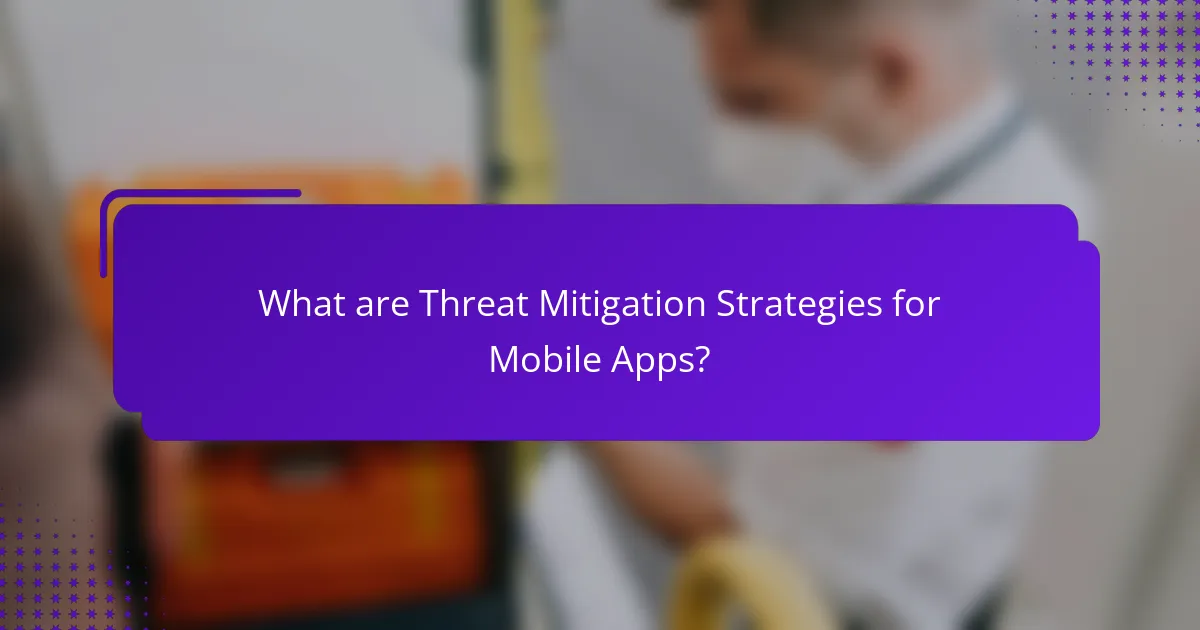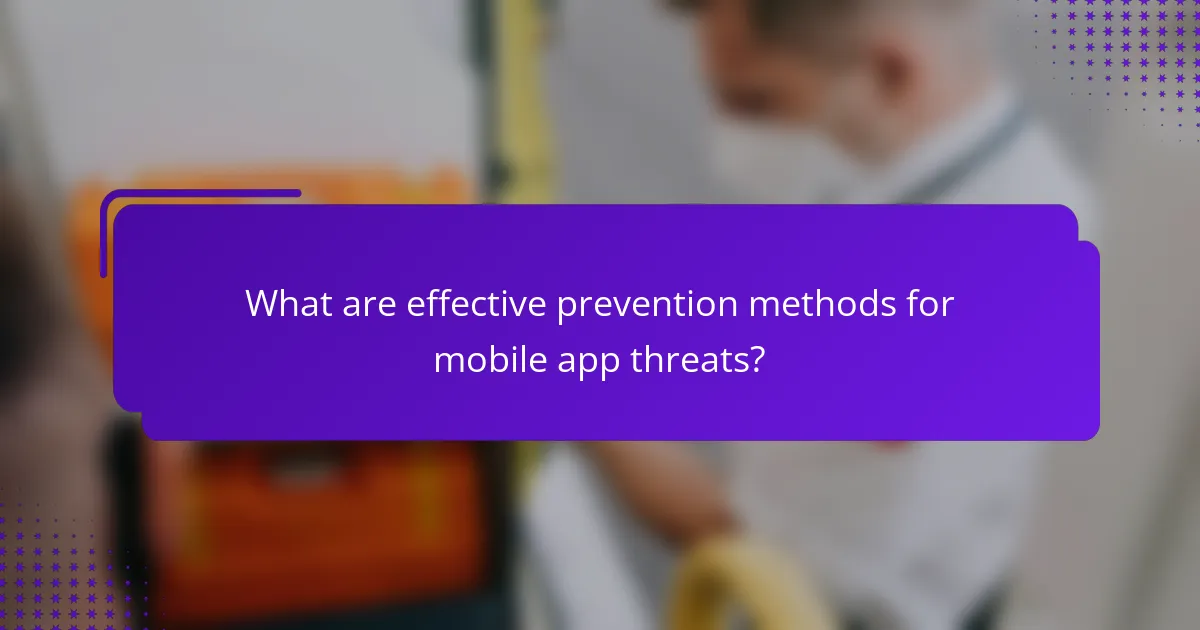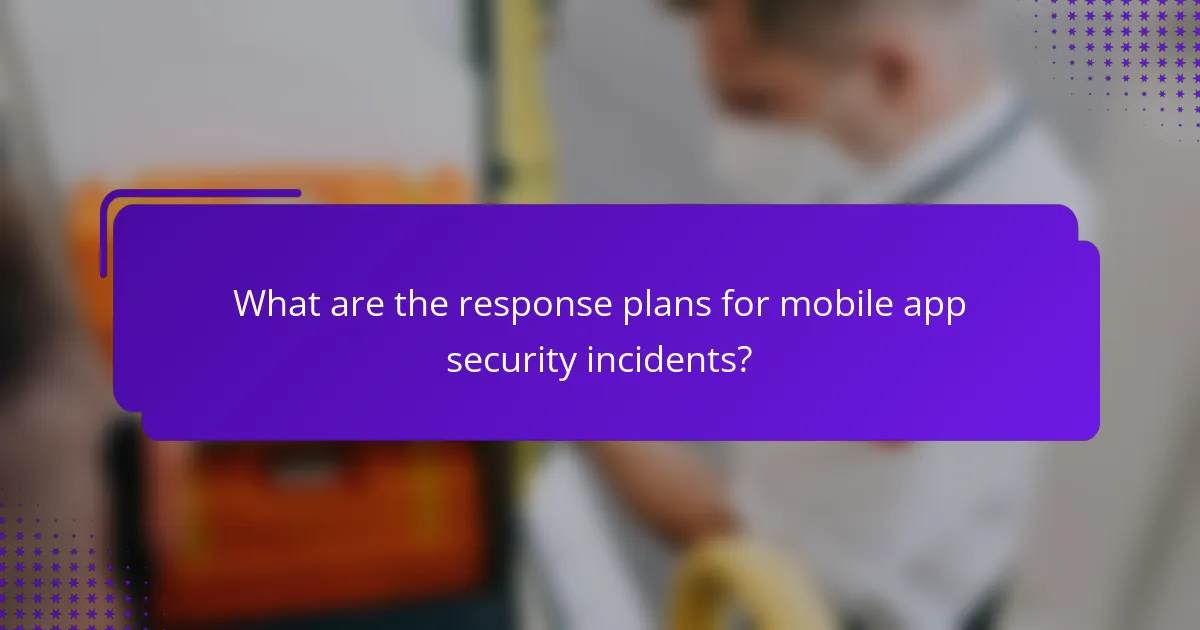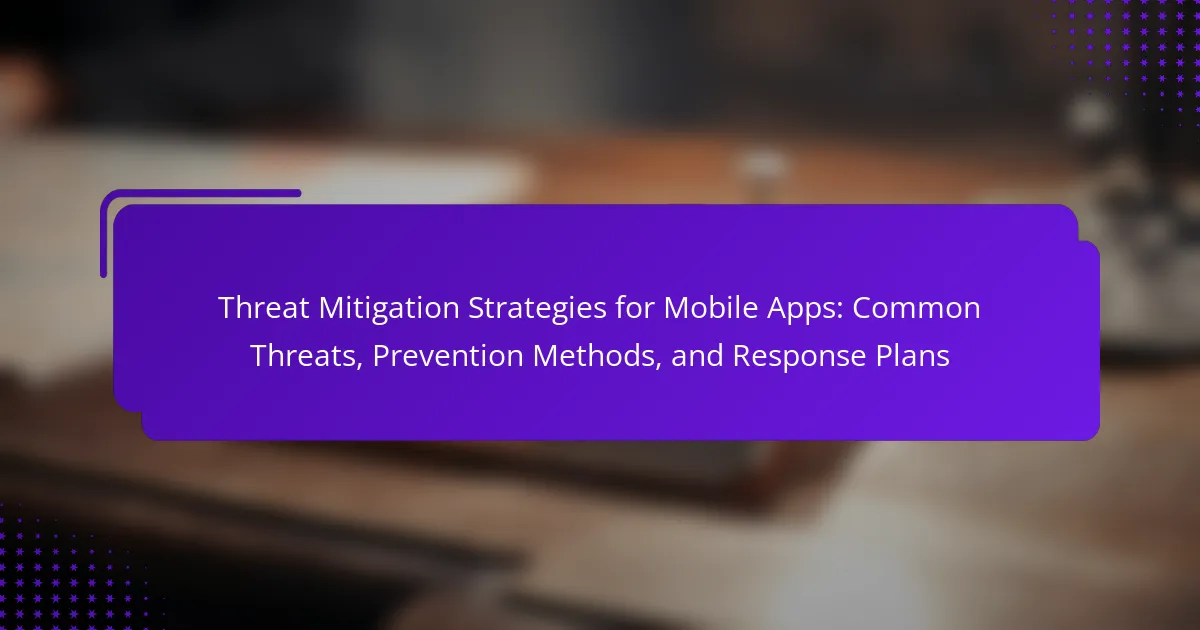Threat mitigation strategies for mobile applications focus on enhancing security and reducing vulnerabilities. Key methods include implementing secure coding practices, conducting regular security assessments, and utilizing encryption to protect sensitive data. Strong authentication measures, such as multi-factor authentication, and regular software updates are essential for addressing potential threats. In the event of a security incident, established response plans involve containment, assessment, eradication, recovery, and communication to effectively manage breaches. This article outlines common threats to mobile apps, prevention techniques, and structured response strategies to safeguard user data and maintain application integrity.

What are Threat Mitigation Strategies for Mobile Apps?
Threat mitigation strategies for mobile apps include implementing secure coding practices, conducting regular security assessments, and utilizing encryption. Secure coding practices help prevent vulnerabilities during the development phase. Regular security assessments identify potential threats and weaknesses in the app. Encryption protects sensitive data both in transit and at rest. Additionally, employing multi-factor authentication enhances user security. Keeping software updated addresses known vulnerabilities. Educating users about security best practices further strengthens defenses. These strategies collectively reduce the risk of security breaches in mobile applications.
Why are Threat Mitigation Strategies important for Mobile Apps?
Threat mitigation strategies are crucial for mobile apps to protect sensitive user data. Mobile applications often handle personal information, financial data, and credentials. Without proper mitigation, these apps become vulnerable to cyber threats. According to a report by Veracode, 83% of mobile applications contain at least one security flaw. Effective strategies reduce the risk of data breaches and enhance user trust. They also help comply with regulations such as GDPR and CCPA. By implementing these strategies, developers can safeguard their applications against malware, phishing, and unauthorized access. This proactive approach is essential for maintaining the integrity of mobile app ecosystems.
What are the potential consequences of inadequate threat mitigation?
Inadequate threat mitigation can lead to severe security breaches. These breaches may result in unauthorized access to sensitive data. Personal information, such as user credentials, can be compromised. Financial losses can occur due to fraud or theft. Organizations may face legal penalties for failing to protect user data. Reputational damage can lead to loss of customer trust. Recovery efforts can incur significant costs and resource allocation. In some cases, inadequate mitigation can result in service disruptions.
How do threat mitigation strategies enhance mobile app security?
Threat mitigation strategies enhance mobile app security by identifying and addressing vulnerabilities. These strategies include implementing encryption, which protects data during transmission. Regular updates and patches fix known security flaws. Conducting security assessments helps detect potential threats before they can be exploited. User authentication mechanisms, such as multi-factor authentication, prevent unauthorized access. Employing secure coding practices reduces the risk of vulnerabilities in the app. According to a report by Veracode, 70% of mobile applications have at least one security flaw. This highlights the importance of proactive threat mitigation in safeguarding mobile apps.
What are the common threats faced by mobile apps?
Common threats faced by mobile apps include data breaches, malware, and insecure APIs. Data breaches occur when unauthorized access leads to the exposure of sensitive user information. According to a report by IBM, the average cost of a data breach in the technology sector is approximately $4.24 million. Malware can infect mobile devices through malicious apps, leading to data theft or device control. A study by Symantec found that 1 in 36 mobile devices had high-risk apps installed. Insecure APIs can expose apps to various attacks, including data manipulation and unauthorized access. The OWASP Mobile Security Project highlights that insecure APIs are among the top vulnerabilities in mobile applications.
What types of malware can target mobile applications?
Malware targeting mobile applications includes several types. These types are viruses, worms, Trojans, ransomware, adware, spyware, and rootkits.
Viruses can attach themselves to legitimate apps and spread to other devices. Worms replicate themselves and can cause damage without user intervention. Trojans disguise themselves as legitimate applications to trick users.
Ransomware encrypts user data and demands payment for access. Adware displays unwanted advertisements and can track user behavior. Spyware collects personal information without user consent. Rootkits allow unauthorized access to the device and can hide malicious activity.
According to a report by McAfee, mobile malware threats increased by 50% in 2020. This statistic highlights the growing concern of malware targeting mobile applications.
How do data breaches affect mobile app users?
Data breaches significantly affect mobile app users by compromising their personal information. Users may experience identity theft, financial loss, and unauthorized access to accounts. According to a report by IBM, the average cost of a data breach in 2021 was $4.24 million. This cost reflects the potential financial impact on users due to stolen credit card information or personal data. Additionally, a study by the Ponemon Institute found that 60% of consumers would stop using an app after a data breach. This highlights the long-term effects on user trust and app retention. Mobile app users must remain vigilant about their data security to mitigate these risks.
What role does insecure data storage play in mobile app vulnerabilities?
Insecure data storage significantly contributes to mobile app vulnerabilities. It allows unauthorized access to sensitive user information. For instance, if an app stores data in plain text, attackers can easily retrieve it. Research shows that over 60% of mobile apps have insecure data storage practices. This can lead to data breaches and identity theft. Proper encryption and secure storage methods can mitigate these risks. Without these measures, apps remain susceptible to exploitation.
How can developers identify threats in mobile apps?
Developers can identify threats in mobile apps through various methods. They should conduct regular security assessments and vulnerability scans. These assessments help in spotting weaknesses in the app’s code and infrastructure. Additionally, implementing static and dynamic analysis tools is vital. These tools analyze code for security flaws before and during runtime.
Developers should also monitor app behavior for anomalies. This includes tracking unusual network activity or unexpected crashes. Utilizing threat intelligence feeds can provide insights into known vulnerabilities. Staying updated with the latest security patches is crucial.
According to a 2021 report by Veracode, 83% of mobile apps contain at least one vulnerability. This statistic underscores the importance of proactive threat identification. Regular updates and security training for developers further strengthen threat detection capabilities.
What tools are available for threat detection in mobile applications?
Threat detection tools for mobile applications include static analysis tools, dynamic analysis tools, and runtime application self-protection (RASP). Static analysis tools, like Checkmarx and Veracode, scan source code for vulnerabilities before execution. Dynamic analysis tools, such as OWASP ZAP and Burp Suite, test applications during runtime to identify security flaws. RASP solutions, like Arxan and GuardSquare, monitor applications in real-time to detect and mitigate threats. These tools are essential for maintaining mobile app security and protecting sensitive user data.
How can threat modeling help in identifying potential risks?
Threat modeling helps in identifying potential risks by systematically analyzing threats to an application. It provides a structured approach to identify vulnerabilities and assess their impact. By mapping out potential attack vectors, organizations can prioritize risks based on likelihood and severity. This process ensures that security measures are aligned with the most significant threats. Research shows that organizations implementing threat modeling reduce security incidents by up to 30%. This proactive approach allows teams to address vulnerabilities before they can be exploited.

What are effective prevention methods for mobile app threats?
Effective prevention methods for mobile app threats include implementing strong authentication measures. This can involve multi-factor authentication to enhance security. Regular updates and patches for apps are crucial to address vulnerabilities. Utilizing encryption for data storage and transmission protects sensitive information. Conducting security audits and [censured] testing helps identify weaknesses. Educating users about safe app usage reduces risks from social engineering attacks. Employing application whitelisting ensures only approved apps are installed. Adopting a secure coding framework minimizes the introduction of vulnerabilities during development.
How can secure coding practices mitigate threats?
Secure coding practices mitigate threats by reducing vulnerabilities in software. They involve techniques that prevent common security issues such as buffer overflows and injection attacks. For instance, input validation ensures that only properly formatted data is accepted. This limits the risk of malicious data being processed. Additionally, using secure libraries and frameworks can help avoid known security flaws. Regular code reviews and testing for security vulnerabilities further enhance the security posture. According to the OWASP Top Ten, implementing secure coding practices can significantly decrease the likelihood of successful attacks.
What are the best practices for secure mobile app development?
The best practices for secure mobile app development include implementing strong authentication methods. This can involve multi-factor authentication to enhance user identity verification. Regularly updating the app and its dependencies is crucial to patch vulnerabilities. Secure coding practices should be applied to prevent common threats like SQL injection and cross-site scripting. Data encryption is essential for protecting sensitive information both in transit and at rest. Conducting thorough security testing, including [censured] testing, helps identify weaknesses. User data should be minimized to what is necessary for functionality. Lastly, compliance with security standards and regulations, such as GDPR or HIPAA, is important for maintaining user trust and legal adherence.
How does regular code review contribute to security?
Regular code review enhances security by identifying vulnerabilities in the code before deployment. This process involves examining the code for potential security flaws, such as buffer overflows and SQL injection risks. According to a study by Google, code reviews can reduce security vulnerabilities by up to 70%. Additionally, regular reviews foster a culture of security awareness among developers. They encourage best practices and adherence to secure coding standards. By consistently applying this practice, organizations can mitigate risks associated with software vulnerabilities.
What role does user education play in prevention?
User education plays a crucial role in prevention by equipping individuals with knowledge to recognize and mitigate threats. Educated users are more aware of potential risks associated with mobile apps. They can identify phishing attempts, malware, and privacy breaches. Studies show that informed users are less likely to fall victim to cyberattacks. For instance, a report by the Cybersecurity & Infrastructure Security Agency indicates that user training reduces the likelihood of successful phishing attacks by up to 70%. Effective user education fosters a culture of security, encouraging safe practices and vigilance. This proactive approach significantly enhances overall threat mitigation strategies for mobile apps.
How can users protect themselves from mobile app threats?
Users can protect themselves from mobile app threats by following several key practices. First, they should only download apps from trusted sources like official app stores. This reduces the risk of malicious software. Second, users must regularly update their apps and operating systems. Updates often include security patches that protect against vulnerabilities. Third, they should review app permissions before installation. Limiting access to sensitive data can prevent unauthorized use. Fourth, users should enable two-factor authentication when available. This adds an extra layer of security to their accounts. Additionally, using mobile security software can help detect and block threats. Finally, users should be cautious about connecting to public Wi-Fi networks, as these can expose them to risks. Following these steps can significantly enhance user security against mobile app threats.
What resources are available for educating users about mobile security?
Educational resources for mobile security include online courses, government websites, and security blogs. Online platforms like Coursera and Udemy offer courses on mobile security best practices. Government resources, such as the Cybersecurity & Infrastructure Security Agency (CISA), provide guidelines and tips for safe mobile use. Security blogs like Krebs on Security and [censured] Security publish articles on the latest threats and preventive measures. Additionally, mobile security apps often include educational materials to inform users about risks. These resources help users stay informed and protect their devices effectively.
What security measures can be implemented in mobile apps?
Security measures that can be implemented in mobile apps include encryption, authentication, and secure coding practices. Encryption protects sensitive data both at rest and in transit. It ensures that unauthorized users cannot access information. Authentication methods, such as multi-factor authentication, verify user identities before granting access. Secure coding practices help prevent vulnerabilities like SQL injection and cross-site scripting. Regular security updates and patches are essential to address newly discovered threats. Additionally, implementing secure APIs can protect data exchanges between the app and servers. These measures collectively enhance the overall security posture of mobile applications.
How does encryption safeguard sensitive data in mobile applications?
Encryption safeguards sensitive data in mobile applications by transforming readable information into an unreadable format. This process ensures that only authorized users with the correct decryption key can access the original data. Mobile applications often handle personal and financial information, making them targets for cyber threats. By employing encryption, these applications protect data during transmission and storage. For example, end-to-end encryption secures messages between users, preventing interception. Additionally, data at rest encryption protects stored data on devices from unauthorized access. According to the 2021 Verizon Mobile Security Index, 43% of organizations reported a data breach due to inadequate encryption practices. Thus, encryption is essential for maintaining data confidentiality and integrity in mobile applications.
What is the importance of using secure APIs in mobile app development?
Secure APIs are crucial in mobile app development to protect sensitive data and maintain user trust. They ensure that data transmitted between the app and server is encrypted. This encryption prevents unauthorized access and data breaches. According to a report by Verizon, 43% of data breaches involve web applications, highlighting the need for secure APIs. Additionally, secure APIs help in authenticating users effectively, reducing the risk of identity theft. They also enable developers to implement access controls, limiting user permissions based on roles. Overall, using secure APIs is essential for safeguarding user information and enhancing the overall security posture of mobile applications.

What are the response plans for mobile app security incidents?
Response plans for mobile app security incidents include immediate containment, assessment, eradication, recovery, and communication. First, containment involves isolating affected systems to prevent further damage. Next, assessment determines the nature and extent of the breach. Eradication follows by removing the threat and vulnerabilities from the app. Recovery restores services to normal operation, often with enhanced security measures. Finally, communication informs stakeholders about the incident and any necessary actions. These steps are supported by established incident response frameworks like NIST SP 800-61, which outlines best practices for handling security incidents effectively.
What should be included in a mobile app incident response plan?
A mobile app incident response plan should include several key components. First, it must define the roles and responsibilities of the incident response team. This ensures accountability and clarity during an incident. Second, it should outline the procedures for identifying and assessing incidents. This allows for quick recognition of potential threats.
Third, the plan needs to detail communication protocols. Clear communication is essential for coordinating responses and informing stakeholders. Fourth, it should specify containment strategies to limit the impact of an incident. This can prevent further damage and protect user data.
Fifth, the plan must include recovery procedures. These steps help restore the app to normal operations after an incident. Lastly, it should incorporate a post-incident review process. This allows for analysis and lessons learned to improve future responses. Each of these components plays a critical role in effectively managing incidents in mobile apps.
How can organizations prepare for potential security breaches?
Organizations can prepare for potential security breaches by implementing a comprehensive security strategy. This includes conducting regular risk assessments to identify vulnerabilities. Establishing a robust incident response plan is crucial for timely action during a breach. Training employees on security best practices enhances awareness and reduces human error. Utilizing encryption for sensitive data protects information from unauthorized access. Regularly updating software and systems closes security gaps. Collaborating with cybersecurity experts provides additional insights and protection. According to Cybersecurity Ventures, global cybercrime costs are predicted to reach $10.5 trillion annually by 2025, highlighting the need for proactive measures.
What steps should be taken immediately after a security incident?
Immediately after a security incident, the first step is to contain the breach. This involves isolating affected systems to prevent further damage. Next, assess the extent of the incident by identifying compromised data and systems. Document all findings meticulously for future reference. Notify relevant stakeholders, including management and affected users, about the incident. Implement recovery procedures to restore systems to normal operations. Finally, conduct a post-incident analysis to identify vulnerabilities and improve future responses. These steps align with established cybersecurity protocols to effectively manage security incidents.
How can organizations learn from security incidents?
Organizations can learn from security incidents by conducting thorough post-incident analyses. This process involves identifying the root causes of the incidents. It also includes assessing the effectiveness of existing security measures. Organizations should document the findings and insights gained from these analyses. This documentation serves as a reference for future incidents. Additionally, they can update their security policies and training programs based on the lessons learned. Regularly reviewing and improving incident response plans is crucial. Research indicates that organizations that analyze incidents can reduce the likelihood of recurrence by up to 50%.
What role does post-incident analysis play in improving security measures?
Post-incident analysis plays a critical role in improving security measures. It involves reviewing incidents to identify vulnerabilities and weaknesses in security protocols. This analysis allows organizations to understand the root causes of security breaches. By documenting findings, teams can develop actionable insights for future prevention. Implementing changes based on these insights enhances overall security posture. Historical data shows that organizations with robust post-incident analysis reduce recurrence of similar incidents by up to 30%. This process not only strengthens defenses but also fosters a culture of continuous improvement in security practices.
How can feedback from incidents inform future threat mitigation strategies?
Feedback from incidents can significantly inform future threat mitigation strategies. Analyzing past incidents reveals vulnerabilities in existing security measures. This analysis helps identify patterns and common attack vectors. Organizations can then prioritize addressing these vulnerabilities. Additionally, feedback provides insights into the effectiveness of current response protocols. Continuous improvement of these protocols enhances overall security posture. Historical data shows that organizations implementing lessons learned experience fewer repeat incidents. For example, the Verizon Data Breach Investigations Report highlights trends in data breaches that inform future defenses. Thus, utilizing feedback from incidents is critical for evolving threat mitigation strategies.
What are the best practices for ongoing mobile app security management?
Implementing ongoing mobile app security management requires continuous monitoring and regular updates. Regularly update the app to patch vulnerabilities. Conduct security audits and [censured] testing frequently. Utilize encryption for data at rest and in transit. Implement strong authentication mechanisms, such as multi-factor authentication. Monitor user activity for suspicious behavior. Educate users about security best practices. Use secure coding practices during development. These practices help mitigate risks and protect sensitive data effectively.
How can regular updates and patches enhance mobile app security?
Regular updates and patches enhance mobile app security by fixing vulnerabilities and bugs. They address known security flaws that could be exploited by attackers. For instance, the 2020 Verizon Mobile Security Index reported that 43% of organizations experienced a mobile security incident due to unpatched vulnerabilities. Updates also improve encryption methods, making data transmission more secure. Additionally, patches can introduce new security features that strengthen overall app defenses. Regular maintenance ensures compliance with evolving security standards and regulations. This proactive approach significantly reduces the risk of data breaches and unauthorized access.
What tools can aid in ongoing security monitoring for mobile apps?
Security monitoring tools for mobile apps include dynamic application security testing (DAST) tools, static application security testing (SAST) tools, and runtime application self-protection (RASP) solutions. DAST tools, like OWASP ZAP, scan running applications for vulnerabilities. SAST tools, such as Checkmarx, analyze source code for security flaws. RASP solutions, like Veracode, monitor applications during runtime to detect and prevent attacks. These tools help identify vulnerabilities and ensure compliance with security standards. Regular use of these tools enhances the overall security posture of mobile applications.
Threat mitigation strategies for mobile apps are essential for safeguarding sensitive user data against various cyber threats, including data breaches, malware, and insecure APIs. This article outlines effective prevention methods such as secure coding practices, regular security assessments, and encryption to enhance mobile app security. It also discusses the importance of user education, incident response plans, and ongoing security management to address vulnerabilities and improve overall defenses. Key tools and frameworks for threat detection and mitigation are highlighted, along with best practices for maintaining mobile app integrity and compliance with regulations.
